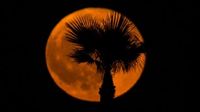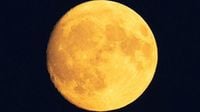On the night of Thursday, July 10, 2025, skywatchers across the United States were treated to a spectacular celestial event: the Full Buck Moon. This full moon, marking the first of the summer, is steeped in tradition and natural symbolism, drawing its name from the period when male deer, or bucks, begin to grow their new antlers. According to NASA, the naming of full moons dates back to the 1930s, rooted in Native American and colonial American folklore that tied lunar cycles to seasonal changes and animal behaviors.
In central Indiana, the Buck Moon appeared especially low in the sky just after the 9:14 p.m. sunset, a rare occurrence linked to a Major Lunar Standstill — a phenomenon that happens only once every 18.6 years. During this event, the sun’s gravity influences the Moon’s orbit to reach its most extreme tilt relative to Earth’s celestial equator, causing the moon to appear either unusually high or low. This year, the timing coincided with Earth’s aphelion, the point in its orbit farthest from the sun, making the Buck Moon the most distant full moon from the sun in 2025.
Brian Wilkes of Indiana captured a striking photo of a young buck in his backyard on July 9, illustrating the very natural inspiration behind the moon’s name. Bucks rapidly grow new antlers during July, sometimes up to an inch per day, with their racks reaching full size by late summer. This biological rhythm has long been observed and celebrated in the naming of the Buck Moon.
Across the country, the Buck Moon was visible at varying times depending on location. In California, for example, the moon reached its peak illumination at 4:36 p.m. EDT (1:36 p.m. PDT) but only became visible as the sun set. Moonrise times ranged from approximately 8:24 p.m. in San Diego and Palm Springs to about 9:20 p.m. in Eureka. Other notable moonrise times included 8:33 p.m. in Burbank, 8:55 p.m. in Salinas, and 9:02 p.m. in San Francisco. Locations such as Joshua Tree National Park, Anza-Borrego Desert State Park, and Prairie Creek Redwoods State Park were recommended for optimal viewing due to their dark skies, offering spectacular backdrops for the celestial show.
Further north in Washington state, the Buck Moon rose in the sign of Capricorn, with moonrise times like 9:42 p.m. in Seattle, 9:43 p.m. in Bremerton, and 9:34 p.m. in Vancouver. The zodiac placement in Capricorn, an earth sign, contrasts with the water sign Cancer on the zodiac axis, adding an astrological layer to the event. Astrologers often link the Buck Moon with themes of growth and renewal, paralleling the natural world’s rhythms.
In Erie County, Pennsylvania, the Buck Moon was predicted to rise at 9:24 p.m., with mostly clear skies and comfortable temperatures around 67 degrees Fahrenheit, perfect conditions for moonwatchers. The moon appeared larger to the naked eye than usual, a visual effect known as the moon illusion, which occurs when the moon is near the horizon. This illusion is particularly notable during the Major Lunar Standstill, enhancing the moon’s size and color, making the event even more memorable.
The Buck Moon is also known by several other names, including the Thunder Moon, Berry Moon, Raspberry Moon, Salmon Moon (notably in the Pacific Northwest, marking salmon runs), and Feather Molting Moon. These names reflect the diverse cultural and ecological significance of the lunar cycle across different regions and traditions.
July’s lunar calendar includes other phases such as the First Quarter on July 2, the Last Quarter on July 18, and the New Moon on July 24. Looking ahead, the next full moon, known as the Sturgeon Moon, will grace the skies on August 9, 2025. Notably, July 2025 does not feature a supermoon; the first supermoon of the year is expected in October.
Adding a cosmic twist to the summer, Mercury enters retrograde from July 17 through August 10. This optical illusion, where Mercury appears to move backward in the sky from Earth’s perspective, is often associated with communication mishaps, travel delays, and technological glitches. Astrologers and the Almanac alike advise caution during this period, which happens three to four times annually.
As the year progresses, the winter solstice will arrive on December 21, 2025, marking the shortest day of the year with approximately 9 hours and 17 minutes of daylight in the Northern Hemisphere. This seasonal milestone contrasts the brightness of the summer’s Buck Moon, reminding us of the cyclical nature of time and celestial rhythms.
For those who missed the July 10 Buck Moon, there’s good news: NASA notes that a full moon appears full for a couple of days, offering multiple opportunities to catch a glimpse. Whether viewed from the deserts of California, the forests of the Pacific Northwest, or the heartlands of the Midwest and East Coast, the Buck Moon of 2025 was a unifying spectacle connecting viewers to nature’s ancient cycles and cosmic wonders.



